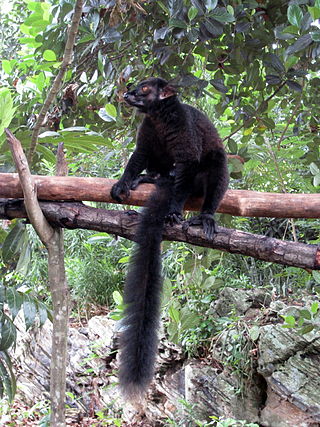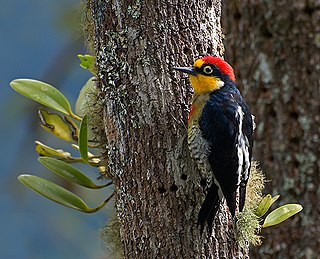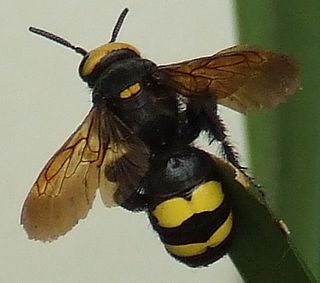
The yellow-throated vireo is a small American songbird.

The black lemur is a species of lemur from the family Lemuridae. Like all lemurs, it is endemic to Madagascar. Originally, the species was thought to have two subspecies, Eulemur macaco macaco and Eulemur macaco flavifrons, both of which were elevated to species status by Mittermeier et al. in 2008 to Eulemur macaco and Eulemur flavifrons respectively. The most startling difference between the two species is the eye colour; Eulemur flavifrons, the blue-eyed black lemur, has blue eyes, while Eulemur macaco, the black lemur, has brown or orange eyes, and also has ear tufts.

The Anthomyiidae are a large and diverse family of Muscoidea flies. Most look rather like small houseflies. Most species are drab grey to black. Many Pegomya are yellow, and some members of the genera Anthomyia and Eutrichota are patterned in black-and-white or black-and-silvery-grey. Most are difficult to identify, apart from a few groups such as the kelp flies that are conspicuous on beaches.

The golden-fronted bowerbird is a medium-sized, approximately 24 cm long, brown bowerbird. The male is rufous brown with an elongated golden crest extending from its golden forehead, dark grey feet and buffish yellow underparts. The female is an unadorned olive brown bird.

A leaf miner is any one of numerous species of insects in which the larval stage lives in, and eats, the leaf tissue of plants. The vast majority of leaf-mining insects are moths (Lepidoptera), sawflies, and flies (Diptera). Some beetles also exhibit this behavior.

The blue-eyed black lemur, also known as the Sclater's lemur, is a species of true lemur. It can attain a body length of 39–45 cm (15–18 in), a tail length of 51–65 cm (20–26 in), a total length of 90–100 cm (35–39 in), and a weight of 1.8–1.9 kg (4.0–4.2 lb). Being a primate, it has strong hands with palms like a human, which have a rubbery texture to give it a firm grip on branches. Its tail is longer than its body and is non-prehensile.

Eopsaltria is a genus of small forest passerines known in Australia as the yellow robins. They belong to the Australasian robin family Petroicidae. The name is derived from the Ancient Greek for "dawn singer/song" because of their dawn chorus. They are inquisitive and bold birds, and have been reported perching on the shoulders or boots of people in the bush. Open eucalyptus woodlands are their preferred habitat. The ornithologist John Gould likened the behaviour and mannerisms of the eastern and western yellow robin to those of the European robin. The name "yellow robin" itself was applied to the eastern yellow robin by the early settlers of New South Wales.

The Samoan whistler, also known as the yellow-fronted whistler, is a species of bird in the family Pachycephalidae. It is endemic to Samoa, where found in forest, plantations and gardens.

The yellow-fronted woodpecker is a species of bird in the family Picidae. It is found in Brazil, Paraguay and far north-eastern Argentina. Its natural habitats are subtropical or tropical moist lowland forests and heavily degraded former forest. It is a fairly common bird with a wide range and the International Union for Conservation of Nature has classified its conservation status as "least concern".

Chalcostephia is a monotypic genus of dragonflies in the family Libellulidae containing the single species Chalcostephia flavifrons. It is known by the common names yellowface and inspector. It is native to central Africa, where it has a widespread distribution. This dragonfly lives in swampy habitats. It is affected by the drainage and reclamation of swamps for agriculture, but it is not considered to be threatened.

Pegomya is a genus of flies within the family Anthomyiidae. Some species are considered pests due to their leafmining larvae. Species include:

Pegomya geniculata is a species of fly in the family Anthomyiidae. It has been recorded in the United States, Ireland, and Switzerland. The insect is fungivorous, and uses the fruit bodies of several mushroom species to breed, such as Verpa bohemica.

The mammoth wasp is a species of wasp belonging to the family Scoliidae in the order Hymenoptera. It is a parasitoid on scarab beetles and is found in Europe and Asia and is the largest wasp found in Europe.

Bombus flavifrons, the yellow-fronted bumble bee or yellowhead bumblebee, is a species of bumblebee. It is native to North America, where it is distributed across much of Canada, Alaska, and the western contiguous United States.
Pegomya carduorum is a species of root-maggot flies.
Pegomya rufescens is a species of root-maggot flies.
Pegomya depressiventris is a species of root-maggot fly.
Pegomya pseudobicolor is a species of root-maggot fly.
Scymnobius flavifrons, the yellow-fronted lady beetle, is a species of dusky lady beetle in the family Coccinellidae. It is found in North America.

Biosteres is a genus of wasps belonging to the family Braconidae.















